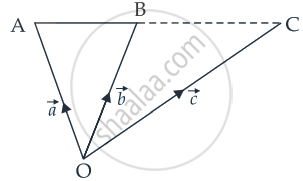Advertisements
Advertisements
प्रश्न
If `vec"a"` and `vec"b"` are the position vectors of A and B, respectively, find the position vector of a point C in BA produced such that BC = 1.5 BA.
उत्तर

Given that BC = 1.5 BA
⇒ `"BC"/"BA"` = 1.5 = `3/2`
⇒ `(vec"c" - vec"b")/(vec"a" - vec"b") = 3/2`
⇒ `2vec"c" - 2vec"b" = 3vec"a" - 3vec"b"`
⇒ `2vec"c" = 3vec"a" - 3vec"b" + 2vec"b"`
⇒ `2vec"c" = 3vec"a" - vec"b"`
∴ `vec"c" = (3vec"a" - vec"b")/2`
Hence, the required vector is `vec"c" = (3vec"a" - vec"b")/2`.
APPEARS IN
संबंधित प्रश्न
Find the position vector of the foot of perpendicular and the perpendicular distance from the point P with position vector
`2hati+3hatj+4hatk` to the plane `vecr` . `(2hati+hatj+3hatk)−26=0` . Also find image of P in the plane.
Find the value of 'p' for which the vectors `3hati+2hatj+9hatk and hati-2phatj+3hatk` are parallel
If `bara, barb, barc` are position vectors of the points A, B, C respectively such that `3bara+ 5barb-8barc = 0`, find the ratio in which A divides BC.
Two collinear vectors having the same magnitude are equal.
Find the direction cosines of the vector `hati + 2hatj + 3hatk`.
Show that the vector `hati + hatj + hatk` is equally inclined to the axes OX, OY, and OZ.
Find the position vector of a point R which divides the line joining two points P and Q whose position vectors are `hati + 2hatj - hatk` and `-hati + hatj + hatk` respectively, externally in the ratio 2:1.
Find the position vector of the mid point of the vector joining the points P (2, 3, 4) and Q (4, 1, – 2).
Show that the points A, B and C with position vectors `veca = 3hati - 4hatj - 4hatk`, `vecb = 2hati - hatj + hatk` and `vecc = hati - 3hatj - 5hatk`, respectively form the vertices of a right angled triangle.
If θ is the angle between two vectors `veca` and `vecb`, then `veca . vecb >= 0` only when ______.
Let `veca` and `vecb` be two unit vectors, and θ is the angle between them. Then `veca + vecb` is a unit vector if ______.
ABCD is a parallelogram. If the coordinates of A, B, C are (−2, −1), (3, 0) and (1, −2) respectively, find the coordinates of D.
Find the angle between the vectors \[\vec{a} \text{ and } \vec{b}\] \[\vec{a} = 2\hat{i} - \hat{j} + 2\hat{k} \text{ and } \vec{b} = 4\hat{i} + 4 \hat{j} - 2\hat{k}\]
Find a unit vector parallel to the vector \[\hat{i} + \sqrt{3} \hat{j}\]
Find the angles which the vector \[\vec{a} = \hat{i} -\hat {j} + \sqrt{2} \hat{k}\] makes with the coordinate axes.
The adjacent sides of a parallelogram are represented by the vectors \[\vec{a} = \hat{i} + \hat{j} - \hat{k}\text{ and }\vec{b} = - 2 \hat{i} + \hat{j} + 2 \hat{k} .\]
Find unit vectors parallel to the diagonals of the parallelogram.
Dot products of a vector with vectors \[\hat{i} - \hat{j} + \hat{k} , 2\hat{ i} + \hat{j} - 3\hat{k} \text{ and } \text{i} + \hat{j} + \hat{k}\] are respectively 4, 0 and 2. Find the vector.
If \[\left| \vec{a} + \vec{b} \right| = 60, \left| \vec{a} - \vec{b} \right| = 40 \text{ and } \left| \vec{b} \right| = 46, \text{ find } \left| \vec{a} \right|\]
If \[\vec{a} = 2 \hat{i} - \hat{j} + \hat{k}\] \[\vec{b} = \hat{i} + \hat{j} - 2 \hat{k}\] \[\vec{c} = \hat{i} + 3 \hat{j} - \hat{k}\] find λ such that \[\vec{a}\] is perpendicular to \[\lambda \vec{b} + \vec{c}\]
If \[\vec{\alpha} = 3 \hat{i} + 4 \hat{j} + 5 \hat{k} \text{ and } \vec{\beta} = 2 \hat{i} + \hat{j} - 4 \hat{k} ,\] then express \[\vec{\beta}\] in the form of \[\vec{\beta} = \vec{\beta_1} + \vec{\beta_2} ,\] where \[\vec{\beta_1}\] is parallel to \[\vec{\alpha} \text{ and } \vec{\beta_2}\] is perpendicular to \[\vec{\alpha}\]
Find the angles of a triangle whose vertices are A (0, −1, −2), B (3, 1, 4) and C (5, 7, 1).
Find the unit vector in the direction of vector \[\overrightarrow{PQ} ,\]
where P and Q are the points (1, 2, 3) and (4, 5, 6).
If \[\overrightarrow{AO} + \overrightarrow{OB} = \overrightarrow{BO} + \overrightarrow{OC} ,\] prove that A, B, C are collinear points.
if `hat"i" + hat"j" + hat"k", 2hat"i" + 5hat"j", 3hat"i" + 2 hat"j" - 3hat"k" and hat"i" - 6hat"j" - hat"k"` respectively are the position vectors A, B, C and D, then find the angle between the straight lines AB and CD. Find whether `vec"AB" and vec"CD"` are collinear or not.
Find the sine of the angle between the vectors `vec"a" = 3hat"i" + hat"j" + 2hat"k"` and `vec"b" = 2hat"i" - 2hat"j" + 4hat"k"`.
Let (h, k) be a fixed point where h > 0, k > 0. A straight line passing through this point cuts the positive direction of the coordinate axes at the points P and Q. Then the minimum area of the ΔOPQ. O being the origin, is
The altitude through vertex C of a triangle ABC, with position vectors of vertices `veca, vecb, vecc` respectively is:
Assertion (A): If a line makes angles α, β, γ with positive direction of the coordinate axes, then sin2 α + sin2 β + sin2 γ = 2.
Reason (R): The sum of squares of the direction cosines of a line is 1.
If points A, B and C have position vectors `2hati, hatj` and `2hatk` respectively, then show that ΔABC is an isosceles triangle.
